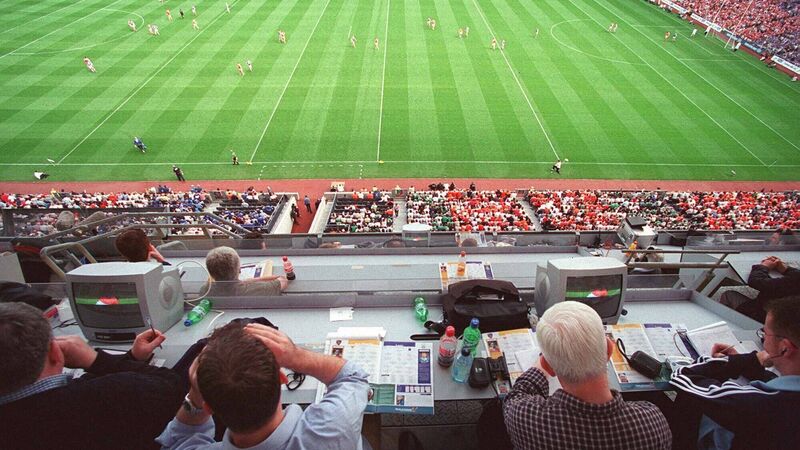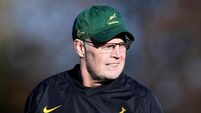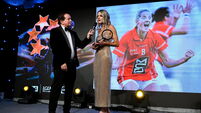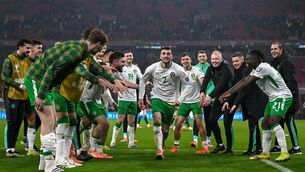Michael Moynihan: The real poetry of what happens

A general view of Croke Park from the press box across to the Hogan stand. Picture: Brendan Moran
Coffee during the week with a pal who’s a teacher in civilian life.
When I finished asking how he filled the countless hours of his summer holidays - and he released me from that friendly headlock - we chatted about the weekend’s football game.
One thing he looked forward to about the sharp end of the championship, he said, was the Irish-language TV commentary on the games when available, and he made a persuasive case for his preference: “I’m not wrapping myself in the green flag so much as going for something that’s sharper in its description.
“When you hear a commentator or a pundit say something like describing players as ‘tine ar chraiceann acu’ just comes across as better than lads just flying it, or being on fire - saying their skin in particular has fire on it. That’s poetry.”
This was a fair point, but I wanted more examples. He obliged.
“Well, when two lads go for the same ball - you know, when you can’t help yourself roaring ‘two of ye there’ as it’s dropping down between them - you get a better description in Irish.”
“I don’t know,” I said. “I think ‘two of ye there’ is pretty good as shorthand, particularly if you roar it.”
“Ha, but not as good as ‘ag teacht salach ar a chéile' - dirtying it up between them is a lot more accurate. And more colourful.”
He had a few more examples to share, not all of which were unfamiliar to me.
I’m fond enough myself of some lad going ‘le luas lasrach' - with lightning speed is slicker than the speed of lightning, and if you don’t appreciate the improvement in the rhythm then I hope I never see you dance at a wedding.
Similarly, I’d concede that it’s far more evocative to be told a player is heading off ‘ar cos in airde’ - legs up is a more pungent description than simply speeding, though legging it is a workable translation.
I pressed him for a couple of favourites on the commentary and punditry side as Gaeilge, and he nominated Dara Ó Cinnéide and Tomás Ó Sé as his favourites.
That’s hardly a surprise, as Kerry Irish would be a good deal more familiar to a Cork ear like his - or mine. When a Galway or Donegal voice has the microphone it’s a little harder to get up to speed.
Harder, but not impossible. I can remember a few years ago there was a good deal of eye-rolling and pearl-clutching when TG4 was covering rugby games, as though a reasonably intelligent person couldn’t equip themselves with the half-dozen phrases necessary to understand sports commentary dealing with their favourite sport, particularly as it’s in a language they spent a dozen years listening to in school . . .
As they say in the first official language of the State, ‘leagfá le tráithnín mé’ (you could have laid me out with a straw), I was so surprised that people were more interested in taking offence than enjoying a new experience.
(I’m sure you can recognise sarcasm when you see it.)
I’m not throwing shade - to use another official language of the State, that of the youth - at Connacht or Ulster Irish when I make that point, by the way. It seems only natural to me that a sport as widespread as Gaelic football in particular should be described in terms particular to specific areas.
Older readers like yours truly probably have an advantage to begin with, however. After all we were reared on first Mícheál Ó Muircheartaigh and then Mícheál Ó Sé providing Irish-language commentary on All-Ireland day for the minor games - when you had minor curtain-raisers - which forged a link between the games, the coverage and the Gaeilge.
No better men to cuir beart le briathar - to put actions with words. Though maybe that should be the other way around?
The race is not always to the swift, nor the battle to the strong, and I was gladdened during the week to realise that sports excellence is not always for the young.
Rosemary Gaffney appeared in the Paralympics for Ireland — she and her horse Werona finished 15th in the Grade IV Dressage, and she told RTÉ: “It has been a dream of mine ever since I had my first accident in 2007, to get to the Paralympics. I’ve been a reserve for the last two and this time I made it. I went into that arena a nobody and came out a Paralympian.”
The reason I mention her here is that Rosemary is 63.
Normally a gentleman like myself would not refer to a lady’s age, but I understand this is a matter of public record and, in any case, is nothing to be shy about. At a time when the default position is that sporting excellence is a matter for the youth and youth alone, it’s encouraging to see someone in their seventh decade appearing in their first Paralympic Games.
For a lot of the week there was a debate about the fitness of Cristiano Ronaldo, at the age of 36, on his way to Manchester United. Full credit to Rosemary Gaffney for putting that debate in proper context.
Many thanks to the reader who got in touch about my championing of Larry McMurty in this zone of interest recently. McMurtry died just a few weeks ago and I confessed my ignorance, something I remedied by devouring Lonesome Dove on holidays.
Anyway: said reader pointed out that I was missing a trick by not trying the rest of the books in the Lonesome Dove series. Duly intrigued I ordered Streets Of Laredo through the excellent inter-branch loan facility of the Irish local library system and it arrived promptly. When I say it’s like sinking into the embrace of a warm bath to return to the dusty Texas plains in the company of Woodrow Call, I do not speak lightly.
The heavy philosophical stuff can wait until next week.









